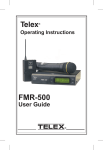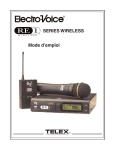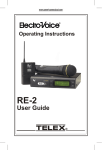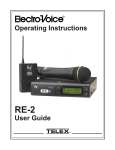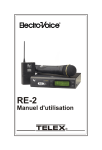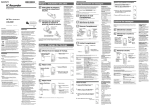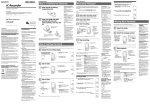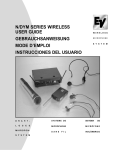Download Tektronix VX4101A Drums User Manual
Transcript
Telex â Operating Instructions Telex FMR-10 R A 1 2 3 4 -20 -10 0 +3 RF CLEAR SCAN TM Diversity Audio Channel B Te lex TR AN ITT ER Tele -10 x SM UH F WT POWE R BAT . O N AUD IO FMR-10 SERIES WIRELESS USER GUIDE R Table of Contents Section Page 1. Quick System Setup Guide . . . . . . . . . . . . . . . . . . . . . . . 1 2. System Description . . . . . . . . . . . . . . . . . . . . . . . . . . . . . 3 3. Detailed system/component setup instructions . . . . . . . . 4 3.1. FMR-10 Receiver Setup and Operation . . . . . . . . . . 4 3.1.1 Rack Mount Installation . . . . . . . . . . . . . . . . . . . 7 3.1.2 Antenna Placement . . . . . . . . . . . . . . . . . . . . . . . 9 3.2. Handheld Transmitter Setup . . . . . . . . . . . . . . . . . . 11 3.3. Bodypack Transmitter Setup . . . . . . . . . . . . . . . . . 13 4. Guidelines/Recommendations for Best Performance . . 16 5. Troubleshooting Guide . . . . . . . . . . . . . . . . . . . . . . . . . 18 6. Technical Specifications . . . . . . . . . . . . . . . . . . . . . . . . 19 FCC Information . . . . . . . . . . . . . . . . . . . . . . . . . . . . . . 20 Accessories and Replacement Parts. . . . . . . . . . . . . . . . 21 1. Quick System Setup Guide Receiver Setup 1. Plug power supply cord into the back of the receiver and plug the power supply into an outlet. The channel display & red/green “Diversity” light on the receiver front panel should light up. 2. Attach the supplied 1/4 wave antenna’s to the FMR-10 receiver. Orient the receive antennas angled up and away from each other (at a 90 degree angle). For specific receiver setup information, refer to section 3.1 for the FMR-10 receiver. Assure that your transmitter(s) are turned OFF. 3. Depress “SET” button on front panel and release when channel display starts to flash (about 3 seconds). This activates “ClearScan™” to find an interference free channel for operation. Note the channel (0 - 9) shown on the receiver front panel channel display. 4. Connect receiver audio output to mixer or amplifier. Mute or reduce mixer gain. -1- Transmitter Setup 1. Open battery compartment, install 9 Volt battery. Make sure to observe proper battery polarity. 2. Adjust channel setting to match channel number shown on receiver channel display. Replace battery cover. 3. If using bodypack transmitter, plug the microphone into the transmitter connector. Operating the System 1. Turn transmitter ON via the ON/OFF switch. After a few seconds, the yellow “Tx On” light should illuminate on the receiver front panel. 2. Turn audio switch to the ON position to the audio. 3. Set mixer amp gain to normal position. 4. Talk/sing into the microphone at a normal volume. You should hear audio coming out of the system. 5. If the signal is distorted, turn the gain adjust control on the transmitter down. If the signal level is low, you may need to turn the gain adjust control up. -2- 2. System Description The Telex FMR-10 Wireless is a series of 10 channel frequency agile UHF wireless systems that combine Telex’s legendary quality and reliability with high value. The transmitters and receivers operate in the UHF frequency range. The well-designed audio circuitry ensures excellent signal-to-noise ratio with accurate sound quality. System Features · 10 Channel Frequency Agile UHF system operation. · Featuring “ClearScan™” which makes for quick and easy system setup. · Handheld transmitters feature Electro-Voice N/DYM mic elements, for superior sound quality. · True-diversity system with Posi-Phase™ insures maximum range and freedom from interference. · Well-designed companding and audio circuitry insures high signal-to-noise ratio and excellent sound quality. · Receivers may be rack-mounted with included hardware. · FMR-10 output via 3-pin XLR-type balanced mic level connector. -3- 3. Detailed Setup Instructions 3.1 FMR-10 Receiver Setup & Operation 1. Place the receiver where there is a clear line of sight to the area where the transmitter will be used. 2. Attach either the supplied 1/4-wave antennas or two remotely mounted antennas to the antenna connectors on the rear panel of the FMR-10. Be sure and tighten the connectors securely. If the supplied 1/4-wave antennas are used, they must be oriented at a 90o angle as shown in Figure 2. Unlike other diversity wireless systems, two antennas are required for the FMR-10 to operate correctly. SET ANTENNAS AT 90 DEGREES CHANNEL SET BUTTON Telex CHANNEL DISPLAY DIVERSITY LIGHTS RF METER FMR-10 R A 1 2 3 4 -20 -10 0 +3 RF CLEAR SCAN TM Diversity Audio Channel B AUDIO METER LOCK OUT INDICATOR Figure 1 FMR-10 Front View BALANCED AUDIO OUTPUT Antenna Balanced Mic Level Output Made in U.S.A. Antenna Telex FC C Power 12-15 V AC/DC 700 mA R FMR-10 Canada Patent Pending POWER JACK Squelch Tested to Comply with FCC Standards llll llll llll llll lllllll llll SQUELCH CONTROL Figure 2 FMR-10 Rear View 3. Connect the power supply cord to the receiver. Plug the power supply into an AC outlet. Confirm that the receiver is ON by checking for the lighted channel display and diversity led’s on the front panel. NOTE: Upon power-up, the receiver will return to the channel it was set to when it was turned off. -4- CAUTION: Please make sure that the AC adapter is the correct voltage for your local requirements. 4. ClearScan™: The FMR-10 Wireless system features ClearScan™. ClearScan™ automates the process of finding a clear channel to use in setup of your FMR-10 Wireless system. To use ClearScan™, depress and hold down the set button for 3 seconds. When the channel display begins flashing release the set button. The receiver is now searching for a clear frequency by measuring the RF energy present on each channel. The entire process will take about 5 seconds. While scanning, the channel display will show the channel number being scanned. When ClearScan™ is complete, the display will stop flashing and it will display the number of the channel recommended for use. NOTE: If using more than one FMR-10 system, set up ONE system at a time. Turn on the transmitter for the first system, before using ClearScan™ to set up the second. Please see the “Guideline/Recommendations for best performance” section of the FMR-10 User’s Guide to set up more than two systems. 5. Setting the Channel: Changing the channel on the receiver can also be done manually. By momentarily depressing the set button, the channel number is increased by one. NOTE: when the system is turned off, the channel number is saved in non-volatile memory. When the receiver is turned on, it will return to the same channel number. 6. Channel Change Lock-out: Once the channel has been set on the receiver, the FMR-10 system has the capability to deactivate or lock-out the channel change button. This is done by depressing the set button for 10 seconds or more. Lock-out is active when the decimal point illuminates in the lower right corner of the channel display. This will defeat the set button. To override or defeat the lockout function, again depress the set button for 10 seconds. This will reactivate the channel set button to work normally. This function can be useful where unauthorized personnel have access to the receiver. -5- NOTE: If the system is in “lock-out”, ClearScan™ will not function. 7. Make sure the gain setting is muted or turned down on the mixer or amp channel you will connect the wireless system to. 8. Plug the audio cable (not supplied) into the output connector. NOTE: The 3-pin XLR-type connector output level is fixed, and cannot be adjusted. Now refer to details located in the FMR-10 User’s Guide on how to set up the transmitter. Once the Transmitter has been set-up, and turned on... 9. Speak or sing loudly into the microphone and observe the Audio level meter on the receiver. Adjust the gain control on the transmitter to prevent over or under modulation. The gain should be adjusted so that the signal peaks are no more than -10dB and that there is at least -20dB or audio level meter indication. 10. “Walk” the expected area of use to check for dropouts or interference. To minimize the potential for dropouts or interference, please observe good antenna placement. When the transmitter is turned on, the RF meter on the receiver should be illuminated in the green range to verify it is receiving a strong signal. 11. Adjust the squelch control if necessary. The squelch control on the back of the receiver may be adjusted to effectively increase range or to reduce interference. The factory setting is at a midpoint, which should be suitable for most situations. To effectively increase range, turn the control counter-clockwise until you hear noise or interference, then, turn the squelch clockwise until the noise is muted. To reduce interference, turn the control clockwise. NOTE: If the squelch is being adjusted, the transmitter should be turned off. CAUTION! Increasing the range will make the system more susceptible to outside interference! Reducing interference will also effectively decrease the range, which will make the system more susceptible to dropouts. -6- 3.1.1 Rack Mount Installation The FMR-10 is supplied with rack mounts for single and double mounting in a standard EIA 19”/ 483mm equipment rack (see Figure 3). For rack mounting a single unit, a long and short “ear” are used. For dual side-by-side mounting, use the short “ears” and the mid sized brackets from two FMR-10 as shown. To assemble the rack mount adapters to the unit(s) and install into a rack, proceed as follows: 1. Remove the front Phillips head screws from each side of each unit. 2. Align the correct rack ear or bracket with the holes on the side of the unit. Install the previously removed screws. Insert an additional screw (provided in the parts pack) into the remaining hole. Repeat this step for the opposite side of the unit. Be sure to tighten all screws securely. For double mounting of two systems, proceed as follows: 1. Align the mid-sized brackets (Item #2) with the holes on the adjacent sides of each unit. 1 REMOVE SCREWS (TYPICAL 4 SIDES) 6 CLE SC AR AN 5 Chan nel Divers ity 1 AUD IO 2 3 4 6 FM R-1 0 3 CLE SC AR AN 2 Chan nel Divers ity 1 AUD IO 2 3 4 (TYPICAL BOTH SIDES) 5 FM R-1 0 1 6 4 (TYPICAL ALL SIDES) Figure 3 Rack Mount Installation -7- 2. Install the previously removed screws. Insert an additional screw (provided in the parts pack) into the remaining holes. Tighten all screws securely. 3. Place the two assemblies side-by-side with the mid brackets together. (The left bracket should fit above the right so that the countersinks are visible). Install 4 flat-head screws (Item #5) and tighten them securely. 4. Attach the antenna connectors to the brackets. 5. Attach the supplied extension cables from the rack connectors to the antenna connections on the back of the receiver. 6. Place the assembly into the rack enclosure and insert 4 #10-32 x 3/8” Phillips pan head screws (supplied) in each corner of the rack ears and secure to the enclosure. Some rack enclosures require metric screws which are not supplied. Ch ann el Div ersi ty AU DIO FM R-1 0 Ch ann el Div ersi ty AU DIO Figure 4 -8- FM R-1 0 3.1.2 Antenna Placement For any wireless system to perform correctly, strong RF signals are mandatory. To maximize signal strength, good antenna placement must be utilized. Although some situations prohibit perfect antenna placement, here are some guidelines: 1. The antennas should be placed in a location with a clear signal path to the transmitter. Walls, ceilings, metal objects, equipment racks, etc. are all signal barriers that will reduce range and performance. Generally speaking, placing the receiver at an elevated location can help increase range and signal strength. Figure 5 1/2-Wave antenna for Remote Mounting Figure 6 2. If the receiver is rack-mounted, external antennas are necessary. Do not rack mount the FMR-10 with the antennas mounted directly on the back of the unit. This will severely decrease the range and performance of the system. If the FMR-10 is rack-mounted, make sure the antennas are front-mounted (following the directions noted above). If antennas are mounted remotely from the chassis, the 1/4-wave antennas supplied with the receiver cannot be used. 1/2-wave antennas are a necessity if the antennas are remote-mounted and can provide better performance when used with the rack mount. -9- If antennas are remote-mounted, separating them 6 feet (1.8m) or more and keeping them at least 2 feet (.6m) from other barriers will improve performance (see Figure 8). If you are remote mounting the antennas and require strong signal over a large area, consider using highly directional antennas such as a log-periodic. The ALP-450 available from Telex is tuned for frequencies from 450-900 MHz and can provide an additional 5 dB of gain. 3. If you remote-mount the antennas, attention should be paid to the type and quality of the antenna cable. For cable runs longer than 25-ft. (7.6m), special low-loss cables should be used. MICROPHONE STAND MOUNTING 6 FT (2 METERS) MINIMUM DISTANCE 2 FT (60 CM) MINIMUM DISTANCE Telex FMR-10 R A CLEAR SCAN TM 1 2 3 4 -20 -10 0 +3 RF AUDIO B Telex FMR-10 R A CLEAR SCAN TM Diversity Channel 1 2 3 4 -20 -10 0 +3 RF Diversity Channel AUDIO B BRACKET SHOULD BE AT TOP OF MOUNTING SURFACE. SIDE MOUNTING Figure 7 Figure 8 4. If multiple wireless systems are being used, a multi-coupler will minimize antenna interference. A multi-coupler has one set of antennas and distributes RF signal to multiple systems. The Telex will supply antenna signal and DC power to 4 systems, eliminating 3 external power supplies and 6 antennas. -10- 3.2 Handheld Transmitter Setup 1. Insert battery. Slide open the hinged battery compartment cover by placing your thumb on the indents of the battery door (at the bottom of the transmitter) and gently pushing down (see Figure 9). Insert the battery, terminal end first, into the compartment, with the smaller positive terminal to the right. SLIDE BATTERY DOOR BACK Telex R Telex e lex R GAIN ADJUST SWING DOOR UPWARD 8 7 Telex 6 R 8 7 9 6 POWER SWITCH 9 0 5 1 2 3 4 MIC SWITCH Figure 9 0 5 1 2 3 4 CHANNEL SET SWITCH Figure 10 2. Set handheld transmitter channel to match the channel setting on the receiver (channel number displayed on front of receiver panel). The channel setting on the handheld transmitter is accessed through the round opening on the side of the mic housing. Numbers 0 - 9 are printed around the opening. The channel setting is determined by which number the arrowed slot is pointing to. Use a small screwdriver (supplied) to change the channel setting. See Figure 10. 3. Turn on the transmitter by sliding the power switch (closest to the battery compartment) forward to the ON position (toward the windscreen). The red battery condition light should flash once and then go out. If the red light stays on or illuminates during a performance, the battery should be replaced immediately. The green light will stay lit when the handheld transmitter is on. Note: Remember to turn the transmitter OFF when not in use. This will conserve battery life. -11- 4. Verify Reception. When the transmitter is turned on: (FMR-10) the RF meter will illuminate, indicating that the receiver is picking up the signal. If this does not happen, make sure that the transmitter and receiver are set to the same channels. 5. Unmute the audio by sliding the audio switch (immediately below the mic element) towards the windscreen. Speak or sing into the microphone and you should hear your voice through the PA / sound system. 6. Adjustment of the transmitter audio gain - if necessary. The transmitter audio gain is set to a mid level which should be suitable for most situations. However, for loud or soft speakers or singers, an adjustment may be necessary. First, speak or sing into the microphone and listen closely. If the gain is too high, you will hear distortion, and if the gain is too low, the signal will be low. In either situation, an adjustment may be necessary. To adjust the transmitter gain, gently insert the provided screwdriver (or other 3/32-in./2.4mm screwdriver) into the hole near the head of the transmitter (see Figure 12). Turn lightly until the screwdriver tip drops into the slot in the level control. Gently turn counterclockwise until the control stops (the mic output is attenuated but not “off”). Slowly turn the mic-level control up while listening to the audio. If the audio becomes distorted, turn the mic level control down (counter-clockwise) about 1/8 turn. Note: Operate with the transmitter audio gain set as high as possible without distortion, for the best signal to noise ratio. 7. Test performance. Check to see that the RF meter on the FMR-10 receiver is illuminated, an indication that the receiver is picking up the signal. Then, “walk” the intended area of use and make sure that there are no barriers to reception or sources of interference. If problems are encountered, see Troubleshooting Guide. -12- 3.3 Bodypack Transmitter Setup 1. Insert battery. Open the hinged battery compartment by placing your thumb or finger on the indent labeled OPEN on the battery door and pushing down, see Figure 11. When inserting the battery, pay attention to the polarity (+/-) and insert the terminals into the battery compartment first. Close the battery door by sliding the door shut. 2. Set the transmitter channel to match the channel setting on the receiver. The channel switch on the bodypack is located just underneath the battery door, and to the right of the indent labeled OPEN. Note the channel number label (0-9) surrounding the opening. The bodypack channel must be set to the same number as the receiver channel, which is displayed on the receiver front panel. The channel setting is determined by which number the arrowed slot is pointing to. Use a small screwdriver (supplied) to change the channel setting. BELT CLIP MAY BE TURNED 90 DEGREES BY REMOVING SCREW AND REINSTALLING HERE. GAIN ADJUSTMENT CHANNEL SWITCH DOOR OPENED BUT NOT SWUNG UPWARD SWING DOOR UPWARD TO ACCESS BATTERY COMPARTMENT TO OPEN BATTERY DOOR PRESS ARROW WITH INDEX FINGER AND PULL DOWN WITH THUMB AND MIDDLE FINGER Figure 11 Channel Switch -13- 3. Turn on the transmitter by sliding the power switch to its on position. Check the condition of the battery by watching the light below the power switch. The red battery light should flash once and then go out. If the light stays on, the battery is weak and should be replaced. ANTENNA POWER SWITCH AUDIO SWITCH POWER O N MIC CABLE ENTRY AUDIO O F F BAT. BATTERY LIGHT Figure 12 4. Verify reception. When the transmitter is turned on: (FMR-10) the RF meter will illuminate, indicating that the receiver is picking up the signal. If this does not happen, make sure that the transmitter and receiver are set to the same channels. 5. Connect the audio source. If using a lavalier or headworn microphone, insert the connector on the end of the mic wire, into the connector on the bodypack. If using a lavalier mic, use the clip to attach the mic to the users clothing. If using the headworn mic, place the headset on the user’s head, positioning the mic at the corner of their mouth. Note: Keep the audio muted while plugging in and adjusting the microphone or source. Placement of lavalier and headworn microphones will noticeably change the sound quality, so some testing with the user is necessary. An important point to remember, the closer to the sound source, the stronger or louder the signal. 6. Unmute the audio, by sliding the large AUDIO switch located on the bodypack, to the ON position. Speak or sing into the microphone and you should hear your voice through the PA / sound system. 7. Listen carefully to the audio and be sensitive of overload distortion and low gain. -14- 8. Adjust the transmit gain if necessary. Gently insert the provided screwdriver or other 3/32-in. 2.4mm screwdriver into the gain adjustment located at the top edge of the battery compartment under the door (see Figure 11). The door has to be opened but not swung upward to make adjustments. Turn lightly until the screwdriver tip drops into the slot on the level control. Gently turn the control counterclockwise until the control stops (the audio output is attenuated but not “off”). Slowly turn the audio level control clockwise while listening to audio; if the audio becomes distorted, turn the mic level control counter-clockwise about 1/8 turn. 9. Test performance. Check to see that the RF meter on the FMR-10 receiver is illuminated, an indication that the receiver is picking up the signal. Then, “walk” the intended area of use and make sure that there are no barriers to reception or sources of interference. If problems are encountered, see Troubleshooting Guide. 10. Clip the bodypack to the user’s belt or pocket. The bodypack can be positioned horizontally or vertically by moving the belt clip attachment. This is done by removing the belt clip attachment screw, rotating the clip to the desired position, and replacing the screw. -15- 4. Guidelines/Recommendations for Best Performance Compatibility The receiver and transmitter must be set to the same channel to operate together. Using Multiple Wireless Systems If two or more FMR-10 Wireless and/or other VHF/UHF wireless systems are being used in the same location, proper frequency coordination is necessary to avoid interference. The following FMR-10 System channels will work together: FMR-10 FREQUENCIES LOW BAND Channel Number 0 1 2 3 4 5 6 7 8 Compatible Systems within Low Band ✔ ✔ ✔ 9 ✔ ✔ ✔ ✔ Operating Frequency 707.45 708.25 709.25 710.05 711.65 713.85 715.25 718.85 720.50 TV Channel 53 53 53 54 54 54 54 55 55 Channel Number 0 1 2 3 4 5 6 7 8 721.45 55 9 TV Channel 56 56 56 57 57 57 58 58 58 Channel Number 0 1 2 3 4 5 6 7 8 58 9 HIGH BAND Channel Number 0 1 2 3 4 5 6 7 8 Compatible Systems within High Band ✔ ✔ ✔ Operating Frequency 725.45 726.25 727.25 728.35 729.65 732.65 734.05 736.45 737.05 9 ✔ 737.85 ✔ ✔ ✔ Compatible Systems within High & Low Band ✚ ✚ ✚ ✚ ✚ ✚ ✚ ✚ ✚ ✚ Contact your dealer or Telex for assistance, if you are planning to add more wireless systems to be operated simultaneously in the same location. -16- Multiple System Setup & ClearScan™ ClearScan™ is most useful for finding operating frequencies for situations where no more than 2 systems will be used simultaneously. When setting up more than 2 systems, use ClearScan™ to choose the first channel of operation. Set up subsequent systems following the channel groupings listed above in the “Using Multiple Wireless Systems” section. Potential Sources of Interference There are many potential sources of interference for your wireless system. Any electronic product that contains digital circuitry including digital signal processors (reverb/multi-effects units), electronic keyboards, digital lighting controllers, CD players and computers, all emit RF energy that can adversely affect the performance of your wireless system. It is always best to place your receiver as far away from these devices as possible to minimize this potential source of problems. -17- Battery Recommendations Fresh 9-volt alkaline batteries from a quality manufacturer will yield the best performance from your FMR-10 transmitters. Rechargeable 8.4-volt Ni-cad batteries can be used, but will yield much shorter operational time. When the transmitter switch is turned on, the red battery light will flash once if the battery is good. If the light does not flash or stays lit continuously, the battery is weak or dead. If the light comes on during use, the battery is weakening and should be replaced as soon as possible. If sound quality degrades during use, it may be the result of a weakening battery. Receiver and Antenna Placement Do not place the receiver near a large metal object or surface. Locate the receiver as close as possible to the area where the Transmitter user will be working. Ideally, position the receiver so that the transmitter is within site of the receiver. When using multiple systems, do not allow antennas to cross or touch each other. -18- 5. Troubleshooting Guide Problem Possible Causes Solutions No audio & no lights on receiver Receiver is off Make sure that power supply is properly connected and providing power to the receiver No audio & no Tx ON light on receiver Transmitter is off Turn on transmitter power switch No (or dead) battery in transmitter Insert fresh battery in transmitter Faulty battery contacts in transmitter Clean contacts Transmitter audio switch is off (signal is muted) Turn on transmitter audio switch Receiver audio cable is damaged or disconnected Connect, repair, or replace cable G a i n not s uf f i c i e nt mixer/preamp/amp input. Increase mixer/preamp/amplifier gain setting No audio Low audio signal Distorted audio signal Interference Short range or drop-outs on Gain set too low (or muted) on mixer/preamp/amplifier I nc r e a s e ga i n s e t t i ng mixer/preamp/amplifier R e c e i ve r a udi o t oo l ow (1/4”/6.4mm output) Increase receiver audio volume setting Transmitter audio level too low Increase transmitter audio gain setting Transmitter audio level too high (overloading transmitter circuit) Decrease transmitter audio gain setting Receiver audio set too high (1/4” 6.4mm output) Decrease receiver audio level setting Battery level low in transmitter Insert fresh battery in transmitter Another wireless product in the immediate area, operating on the same frequency, or on a frequency that mixes with another RF signal (such as a TV broadcast transmitter). Change operating frequency. If interference is weak, keep transmitter on at all times (to override interfering signal) whenever receiver is on. Receiver placed too close to a digital signal processor or similar device. Move receiver to a different location Strong electromagnetic field from stage lighting or other source near the transmitter or receiver, which may be producing RF noise on or near the operating frequency. Change operating frequency. Repair or remove source of interference. Move receiver to a different location. RF reflective metal obstacles between transmitter & receiver. Move the obstacles, or reposition the receiver Poorly oriented beltpack antenna Reorient bodypack so that antenna is positioned vertical (up and down) and facing receiver, if possible Faulty receiving antenna system Reposition antennas or receiver -19- on 6. FMR-10 Wireless Series System Technical Specifications UHF Receivers: FMR-10 Receiver Receiver Type Synthesized PLL Frequency Range (RF) Selected Frequencies between 710-866 MHz (depending on Country of Operation) Number of Selectable Channels 10 Diversity True Diversity with Secure-Phaseä RF Sensitivity < .8 uV for 12 dB SINAD Audio Output, Frequency Response 50-15 kHz +/- 2 dB Audio Output, Balanced (XLR) -20 dBV (600 Ohm Load) Audio Output, Unbalanced (1/4”/6.4mm, NRU only) adjustable 8 mv to 0.775V RMS (100 K ohm load) Distortion (THD) Less than 0.5% Signal-to-Noise Ratio >94 dB Dynamic Range 100 dB UHF Transmitters: WT-10 and HT-10D RF Frequency Range Selected Frequencies between 710 - 866 MHz (depending on Country of Operation) Number of Selectable Channels 10 Radiated RF Output 10-15 mW typical Microphone Element HT-100 handheld EV N/D 767a cardioid N/DYM dynamic TA4F Connector Wiring: Pin 1: Ground; Pin 2: Mic Input; Pin 3: +5 volt bias; Pin 4: +5 volt bias fed through a 3 K ohm resistor for 2-wire electrets Audio Gain Adjustment Range 40 dB beltpacks, 26 dB handhelds Battery Life 8 - 10 hours with 9-Volt alkaline Bodypack Antenna flexible external 1/4 wave Handheld Mic Antenna internal 1/2 wave Size (Handheld transmitter) 10. 13 in. (257mm) long Size (Bodypack transmitter) HxWxD 4.5 in. (114mm) x 2.6 in. (66mm) x 1.3 in. (32mm) (no antenna) -20- FCC INFORMATION The TELEX Receiver FMR-10 is authorized under Part 15 of the Federal Communication Commission. The Telex WT-10 and HT-10D Transmitters are type Accepted under United States Federal Communications Commission Part 74. Licensing of Telex equipment is the user’s responsibility and licensability depends upon the user’s classification, user’s application, and frequency selected. Telex strongly urges the user to contact the appropriate telecommunications authority for any desired clarification. CAUTION: Any changes or modifications made to the above equipment could void the user’s authority to operate the equipment. -21- ACCESSORIES AND REPLACEMENT PARTS Order No. Description 450131 63850006 63850007 64277000 57013001 70925001 70928001 57013001 450124 870343 71081001 71081002 730139 730140 730103 71253000 Plastic belt clip for bodypack WLM-50 tie clip-horizontal WLM-50 tie clip-vertical WLM-50 omnidirectional lapel microphone WLM-50 foam windscreen ELM-22 MicroMini™ omnidirectional lapel mic ELM-22 mic clip ELM-22 foam windscreen Spring-adjusted handheld mic stand adapter Deluxe handheld mic stand adapter Rack-mount kit - Single Rack-mount kit - Double 120-volt power supply (US/Canada type) 230-volt power supply (EURO type) 230-volt power supply (UK type) UAD-2 Antenna/power distribution system (supplies 4 units) (600-780 MHz) 879010 71147000 870658-5 870658-6 71138000 1/4-wave antenna with connector (668-746 MHz) ALP-450 Directional log periodic antenna (450-900 MHz) 1/2-wave antenna with TNC connector (690-725 MHz) 1/2-wave antenna with TNC connector (725-760 MHz) Universal bracket for 1/2-wave antenna with 10 ft. (3.05m) coax cable 71151025 71151050 71151075 71151100 25 ft. (7.62m) coax cable with TNC connectors 50 ft. (15.24m) coax cable with TNC connectors 75 ft. (22.86m) coax cable with TNC connectors 100 ft. (30.48m) coax cable with TNC connectors -22- R Telex Communications Inc., 12000 Portland Ave. South, Burnsville, MN 55337 (952) 884-4051, (800) 828-6107, Fax: (952) 887-9212 PN 803341 May 2001


























